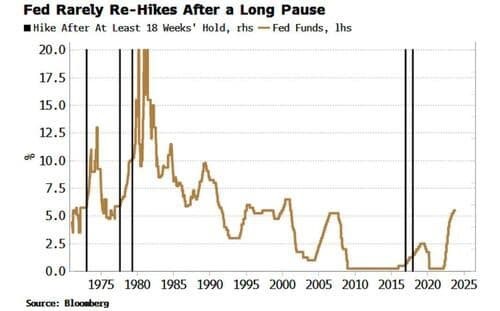December 2023 Newsletter
Ashley Nichols - Dec 15, 2023
Merry Christmas from our team to you and your family! We share a great article regarding the Fed's rate hike pause and what it can mean for the future. Stephen shares his technical comments and Ashley is back with another budgeting Millennial Minute.

Money is a tool. It's something that supports your life!
Another year will soon be behind us, and what a year it's been. Between volatile markets, inflation, cost of living crisis, and the numerous global events unfolding - it's understandable if you're feeling a little less "Christmas-y" this year. However, take this time to hold the ones you love close and enjoy your time with friends and family. Let this holiday season remind us all of our good fortunes, and giving back to those who need it most.
From our families to yours, we wish you all a very Merry Christmas, Happy Hannukah and Happy Holidays, however or wherever you may be celebrating.

Planning Tips
2024's TFSA contribution limit has increased to $7,000. Give us a call to arrange your contribution.
And remember, you can contribute any missed years at any time, so long as you were 18 or older in those years. Any money withdrawn from a TFSA can be recontributed the following calendar year to avoid any over-contribution issues.
Our Portfolio
*We hope you have had the chance to listen to our podcasts this year. We are happy to answer any questions that may come up from listening - and we are always taking suggestions for topics to cover.*
Transactions
November was a strong month recovering all what was lost during September and October. During the month, we sold Exxon, trimmed Apple, Brookfield, Canadian Natural Resources, Cenovus, Costco, Finnig, Lockheed Martin, Lundin, Sun Life and Stelco. We made a large tactical trade at the end of the month, trimming our S&P 500 position by 11% and selling all our Nasdaq position. We are looking at deploying the cash on a pull back in December.
We are currently around 36% cash, 25% bonds and 39% equity.
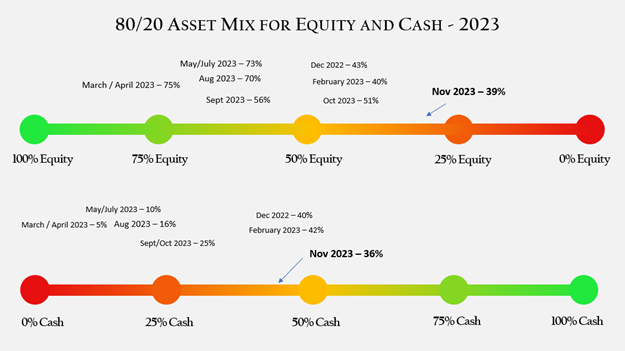
Returns on our 60/40, 70/30 and 80/20 portfolios before fees:
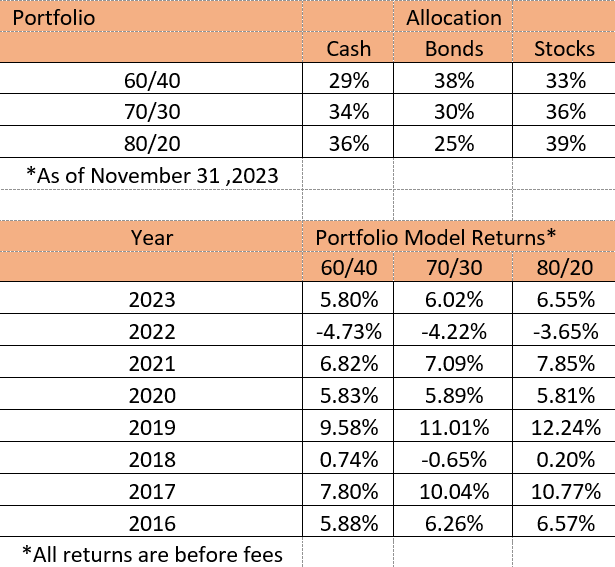
The Fed Pauses: What Comes Next?
An article by Michael Lebowitz | December 6, 2023
After hiking rates by 5.25% since March 2022, the Fed is in a wait-and-see period, commonly deemed a pause. Since the Fed started hiking rates, inflation has declined meaningfully but remains moderately above the Fed’s 2% target. The economy continues to thrive, fueled by a strong labor market.
Despite the good news, a dark cloud lingers on the horizon. The Fed’s primary fear is that the lag effect of prior rate hikes has yet to impact the economy fully. They desire a soft landing, implying little economic degradation. But a much stronger downturn can’t be ruled out in their minds or ours. Given the odd juxtaposition between strong economic growth and recession fears, a Fed pause is the most likely action.
The Fed Funds futures market agrees with our assessment. As we show below, it expects the Fed to pause through February. Starting in March 2024, the market implies increasing odds of the Fed cutting rates.
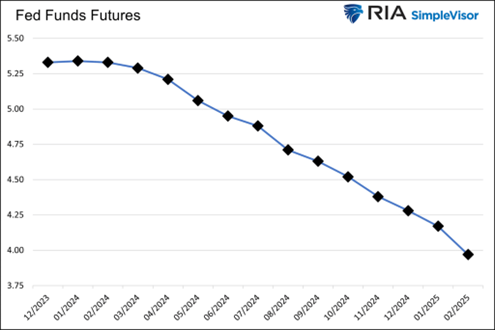
If the Fed is in the pausing stage of the cycle, the logical question is how long it might last. More importantly, how might stocks and bonds perform during the pause and eventually when the Fed cuts rates?
The equity market appears to be giddy at the prospect of rate cuts, but as we will discuss, equity investors should start contemplating risk reduction strategies. Bond investors are the ones that should be giddy!
Stock Investor Giddiness Explained
The November 3, 2023, BLS employment report underwhelmed expectations. However, the bad news was good news. The stock market roared as investors presumed a Fed pause was a done deal. Since then, it has continued rising nearly 6% in only a few weeks. Bonds followed. Over the same period, the U.S. Treasury ten-year note yield has fallen by .50%.
The weaker-than-expected CPI inflation report fueled the notion that the Fed was done.
WSJ reporter Nick Timiraos, the Fed’s media mouthpiece, leads credence to the Fed pause narrative. Shortly following the CPI report, Nick tweeted the following:
“The October payroll report and inflation report strongly suggest the Fed’s last rate rise was in July. The big debate at the next Fed meeting is shaping up to be over whether and how to modify the post-meeting statement to reflect the obvious: the central bank is on hold.“
Stock and bond investors are giddy at the prospect of slower growth and lower inflation. Such outcomes are not good for equity investments. Yet logic is trumped by the hope that the Fed’s next move may be to lower interest rates.
If this rate cycle is like almost all others in the last 100 years, a Fed pause will be followed by rate cuts.
How long of a pause should we expect before rate cuts?
How Long Will A Pause Last?
Nineteen weeks ago, on July 26, 2023, the Fed last hiked rates. The graph below, courtesy of ZeroHedge and Bloomberg reporter Simon White, shows five instances since 1970 when the Fed paused rate hikes for at least 18 weeks and resumed hiking. Only two of the cases were in the last 40 years.
In the accompanying article, Simon writes:
But when rates are already restrictive as they are today, it would be unprecedented. The longest the Fed has held rates after last hiking them, and then raising them again when rates are already restrictive – i.e., when the real Fed rate is greater than the neutral rate (using the Holston-Laubach-Williams estimate) – is 14 weeks, between August and November 1988.
No one can be 100% confident inflation will continue lower. As such, the Fed’s probability of raising rates again is not zero. However, the Fed seems more concerned that the lag effect of the prior 5.25% in rate hikes has yet to fully exert its weight on the economy. It is this dark cloud on the horizon that pressures them to pause.
The last three pause cycles since 2000 lasted 36 weeks on average. Thirty-six weeks from what may be the start of the recent pause puts us in March 2024. As we wrote in the opening, March 2024 is also the month when the Fed Funds futures market starts pricing in rate cuts.
Stocks and Bonds in Pause and Rate Cut Phases
How do stocks and bonds perform during the stages of monetary policy?
The graph below shows Fed Funds (black), the S&P 500 (orange), and 10-year U.S. Treasury bond yields from 1998 to the present. We highlight the rate hike, pause, and rate-cutting cycles with red, yellow, and green, respectively. For this article, we only consider the pause to be after the Fed increases rates.
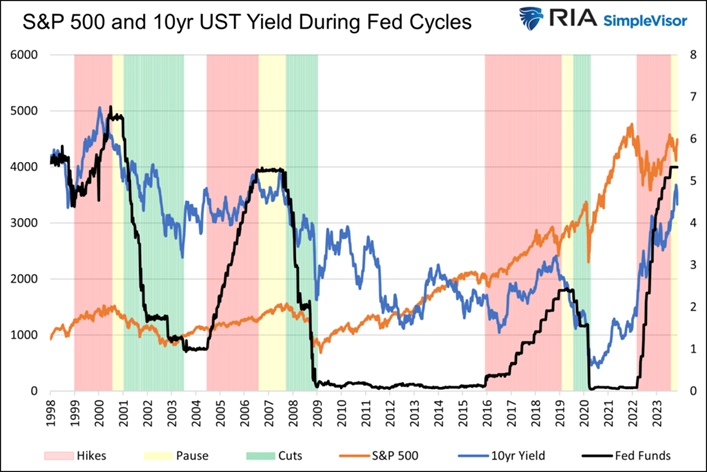
Below, we isolate the three prior and the current partial cycles to appreciate what happens during the three cycles.
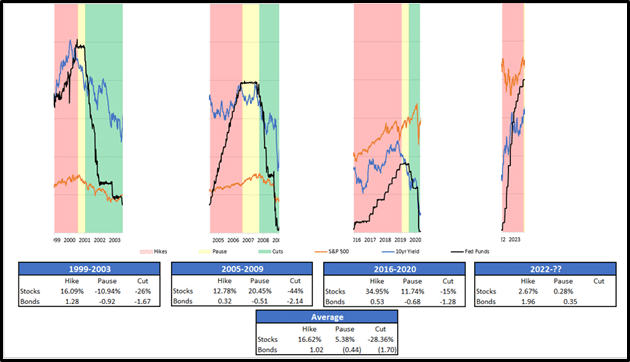
Marrying Historic Returns and Logic
Stocks often do well when the Fed is hiking rates and bond yields typically rise. This occurs because the economy is running above trend, and the Fed will raise rates for fear of inflation. Their aim during such periods is to slow growth back to trend.
The economy is fueled by debt. Accordingly, higher interest rates almost always result in below-trend growth and a recession.
The term “soft landing” is often used during rate hike cycles despite their frequent occurrences. The graph below shows that a rising Fed Funds rate preceded every recession since 1950. The circles show the only instances when Fed hikes did not result in an immediate recession.
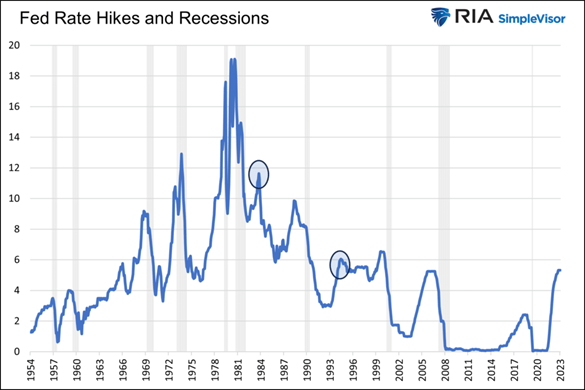
Stock performance is mixed during the Fed’s pausing cycle after rate hikes. As shown above, stocks rose decently before the financial crisis and pandemic but fell before the dot-com bust. Bond yields fall during the pause as investors anticipate slower growth and less inflation. In all three prior periods, yields fell. Currently, yields have risen during the pause but are now trending lower.
Lastly, stocks tend to perform poorly during the rate cuts, and bond yields continue to fall. Such is unsurprising as the Fed typically raised rates too much, and a soft landing turned into a hard landing.
At the bottom of the graphic are the average returns for stocks and bonds for the four periods. As shown, stocks are the investment of choice during rate increases while bond yields rise. The pause period is tricky for stockholders. Bondholders should be comforted during both the pause and the rate-cutting period. Stock investors should consider risk reduction strategies as a rate cut will likely be the next Fed move.
Summary
If history proves prescient and the Fed is genuinely pausing before a series of rate cuts, investors should consider how they might shift their exposures between stocks and bonds.
Within the equity markets, lower beta, more value-oriented stocks, and reduced equities allocations have tempered losses in past rate-cutting environments. On the other hand, bond yields may have already peaked around 5%. The current rate decline may be the tip of the iceberg if a recession is coming.
The risk to our forecast is that history doesn’t always repeat. Secondly, we have zero assurances the Fed has ended its rate hiking cycle. If the Fed raises rates again, the pause clock starts over, and stocks may do better than bonds.
Lastly, the Fed and government may panic as they did in 2020 and provide a bazooka to the equity markets via massive QE and zero interest rates. If so, any decline in equities may be short-lived. Conversely, longer-term bond yields could rise as investors now appreciate how such a massive fiscal and monetary reaction to weakness can generate inflation.
Michael Lebowitz, CFA is an Investment Analyst and Portfolio Manager for RIA Advisors. specializing in macroeconomic research, valuations, asset allocation, and risk management. RIA Contributing Editor and Research Director. CFA is an Investment Analyst and Portfolio Manager; Co-founder of 720 Global Research.
Follow Michael on Twitter or go to 720global.com for more research and analysis.
Customer Relationship Summary (Form CRS)
Interesting Charts
2023 was a year of volatility, and we were all understandably nervous with market conditions and volatility. Hearing how our friends were "beating the markets" and "making 20% returns", but never explaining how, or showing the proof, only helped the majority of investors worry more about running out of money or losing all they've invested.
Below's charts today give a little perspective into investor worries, along with some past performance of past and present "fad stocks".
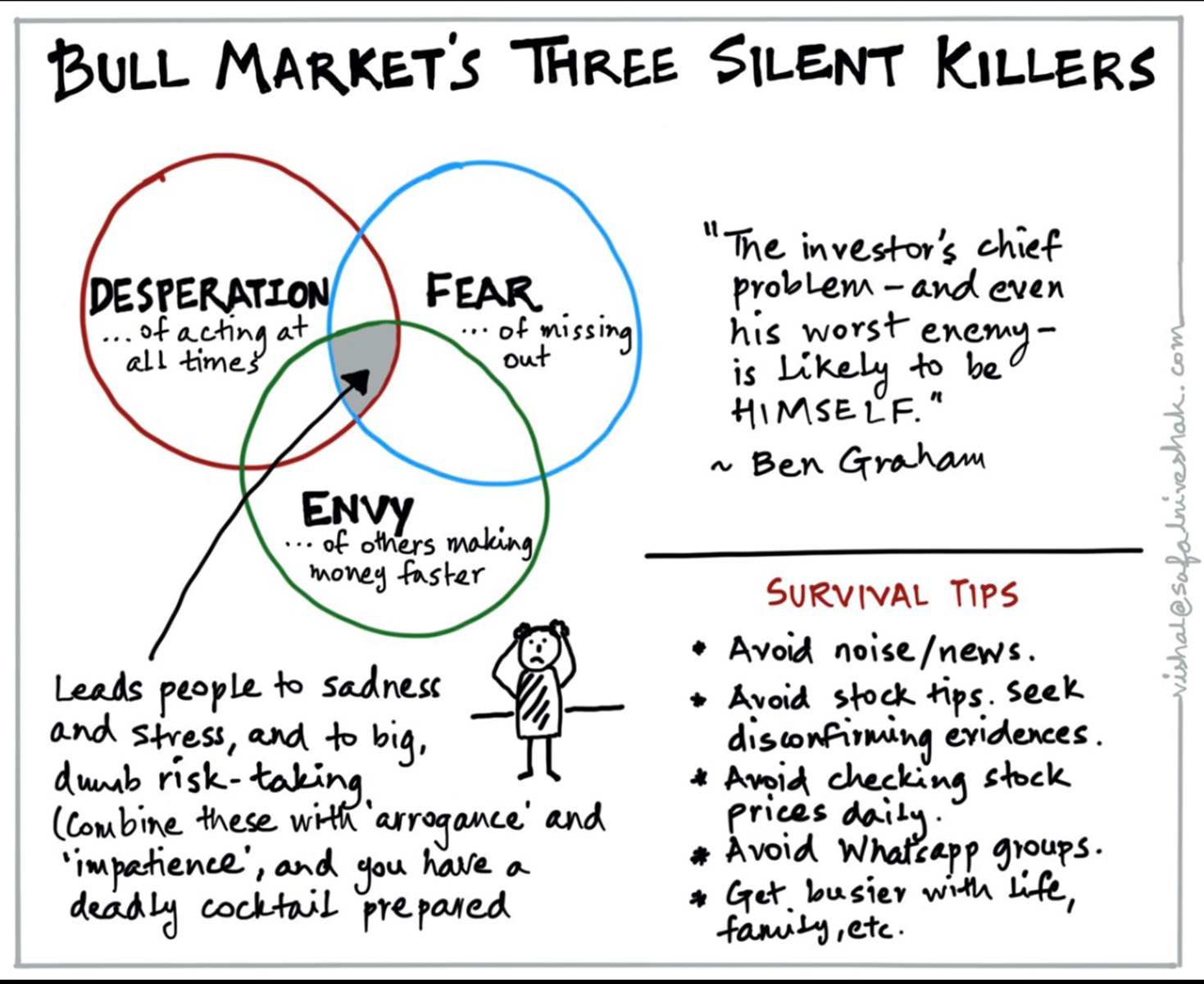
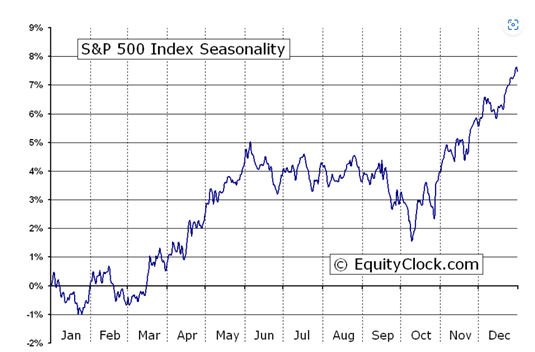
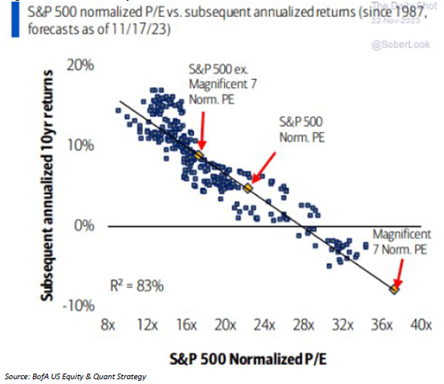
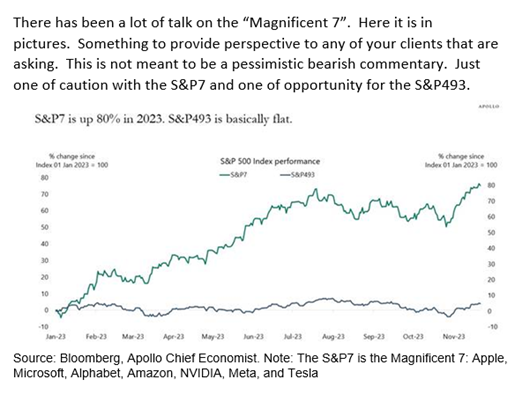
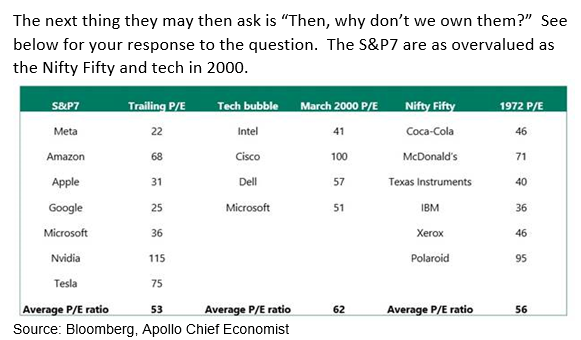
Technical Comments
https://www.brookstradingcourse.com/price-action-trading-blog/
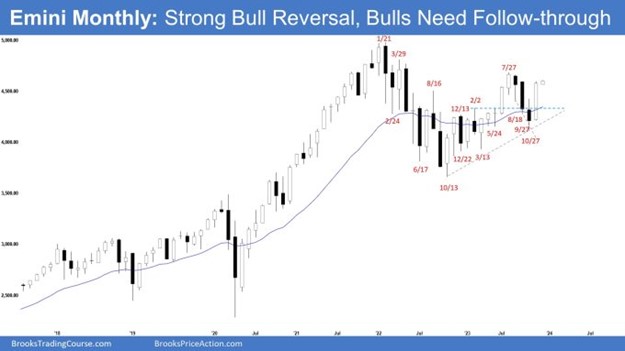
-
The November monthly S&P 500 candlestick was a big bull bar closing near its high and above the October high.
-
Last month, we said that the bull trend remains intact (higher highs, higher lows). If November closes as a bull bar near its high and above October’s high, that will increase the odds of the bull trend resuming.
-
The bears see the current rally as a retest of the July 27 high and want a reversal from a lower high major trend reversal or a double top.
-
They want a larger second leg down (with the first leg being the July to October pullback) and a retest of the October low.
-
Because of the strong rally in November, they will need a strong signal bar before traders would be willing to sell more aggressively.
-
Previously, the bulls managed to create a tight bull channel from March to July.
-
That increases the odds of at least a small second leg sideways to up after the recent pullback (Jul to Oct). The second leg up is currently underway.
-
They got a reversal from a trend channel line overshoot (Oct) and a higher low major trend reversal.
-
They want a retest of the July 27 high and the all-time high followed by a breakout above.
-
They hope that the current rally will lead to a multi-month rally, similar to the candlestick in November 2020.
-
They will need to create a follow-through bull bar in December to increase the odds of the bull trend resuming.
-
Since November is a big bull bar trading near its high, it is a buy signal bar for December.
-
Odds slightly favor December to trade at least a little higher. The July 27 high is close enough and likely to be tested.
-
If the bulls get a follow-through bull bar closing above the July 27 high, it will increase the odds of a retest of the all-time high.
-
For now, the bull trend remains intact (higher highs, higher lows). This remains true.
Millennial Minute
It's that spending time of year! Our wallets get lighter, but so do our hearts with the sounds and joys of the season. This doesn't mean, however, that we can allow our spending to spiral out of control. Now, more than ever, is the time to remember our budgets and keep within them!
Still haven't created a budget? You can read my article this month to help you start one!
Click here to read more!
Planning: Protecting Yourself in the Digital Age
In an increasingly digital age, protecting our customers data is one of BMO’s top priorities. In this short guide, you’ll find simple tips to help you protect your accounts and avoid falling victim to identity theft or fraud.
Click here to read more!

